Your Planets
Portraits of the Planets
Aspects between Planets
The planetary ages
The planetary families
Planets in Signs
The Planets in comics


The less one knows about astrology, the more one makes much of the point of the ecliptic which rises on the eastern horizon, that is to say the Ascendant sign. And yet, it is far from always having the major importance that we give it…
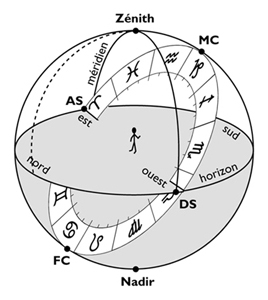 Word “Ascendant” comes from Latin “ascendere”, which means “which rises”. The Rising Sign, at the intersection of the ecliptic (apparent race of the Sun around the Earth) and the horizon, is the rising Sign. The calculation of the Ascendant is the basic operation which makes it possible to carry out the housekeeping, that is to say to the division of the local sphere into twelve sectors called Houses, numbered counter-clockwise and according to the apparent course of the Planets around the horizon; the beginning (or cusp) of House I merges with the Ascendant point. In the figure above, the Ascendant (AS) is in Aries.
Word “Ascendant” comes from Latin “ascendere”, which means “which rises”. The Rising Sign, at the intersection of the ecliptic (apparent race of the Sun around the Earth) and the horizon, is the rising Sign. The calculation of the Ascendant is the basic operation which makes it possible to carry out the housekeeping, that is to say to the division of the local sphere into twelve sectors called Houses, numbered counter-clockwise and according to the apparent course of the Planets around the horizon; the beginning (or cusp) of House I merges with the Ascendant point. In the figure above, the Ascendant (AS) is in Aries.
Let’s take the example of a Sun at 10° Capricorn and observe the relationship between Sun Sign and Rising Sign for an average geographical latitude (45° North). For one day, the duration of the rotation of the Earth on its axis, the 12 signs rise successively on the horizon: Capricorn first, then Aquarius, then Pisces, and so on.
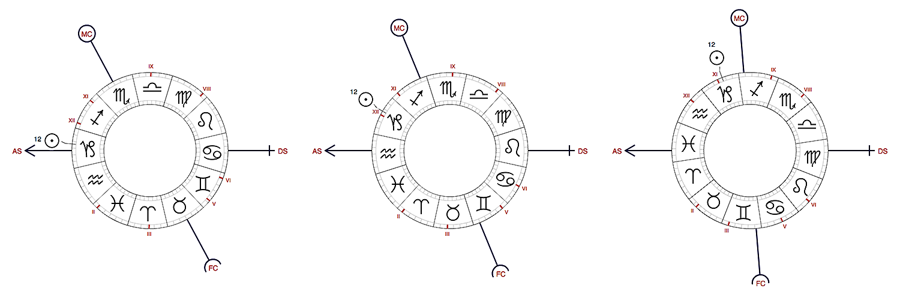
Comment to the figures above:
1) The Sun has just risen; it is just above the horizon, in House XII; the Sun Sign and the Rising Sign (on the left) are therefore the same: Capricorn. Of an individual born at this hour, we will say that he is Capricorn Ascendant Capricorn.
2) The Sun in Capricorn continues to rise above the horizon. He is now in House XI and the Rising Sign (on the left) is Aquarius. Of an individual born at this hour, we will say that he is Capricorn Ascendant Aquarius.
3) The Sun in Capricorn continues to rise above the horizon. It is now in House X, soon to be at the top of its daily course, and the Rising Sign (on the left) is Pisces. Of an individual born at this hour, we will say that he is Capricorn Ascendant Pisces.
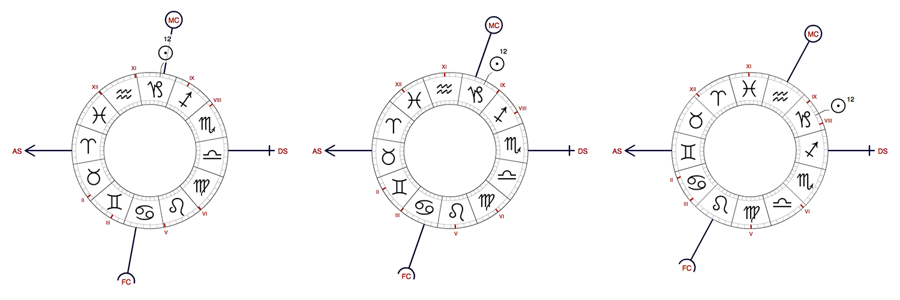
Comment to the figures above:
4) The Sun in Capricorn, which passes through the upper meridian, is at the height of its daily course, at Midheaven. It is a little past noon local time, and it is now in House IX; the Rising Sign (on the left) is Aries. Of an individual born at this hour, we will say that he is Capricorn Ascendant Aries.
5) The Sun in Capricorn descends towards the horizon. It is always in House IX; the Rising Sign (on the left) is Taurus. Of an individual born at this hour, we will say that he is Capricorn Ascendant Taurus.
6) The Sun in Capricorn continues its descent towards the horizon. It is in House VIII; the Rising Sign (left) is Gemini. Of an individual born at this hour, we will say that he is Capricorn Ascendant Gemini.
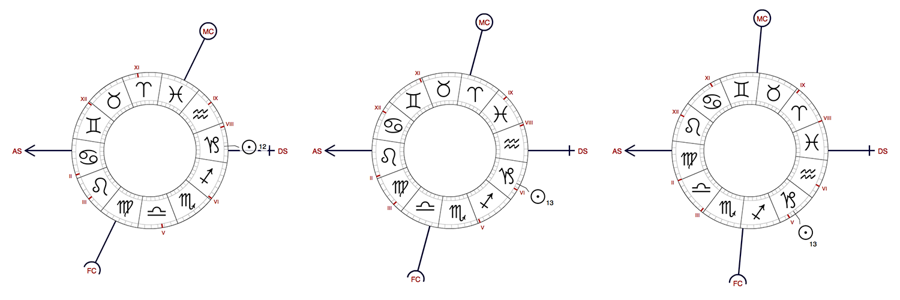
Comment to the figures above:
7) The Sun in Capricorn, just above the horizon, will soon set. It is in House VII; the Rising Sign (left) is Cancer. Of an individual born at this hour, we will say that he is Capricorn Ascendant Cancer.
8) The Sun in Capricorn has passed below the horizon: it is therefore night. It is in House VI; the Rising Sign (left) is Leo. Of an individual born at this hour, we will say that he is Capricorn Ascendant Leo.
9) The Sun in Capricorn continues its course below the horizon. It is in House V; the Rising Sign (left) is Virgo. Of an individual born at this hour, we will say that he is Capricorn Ascendant Virgo.
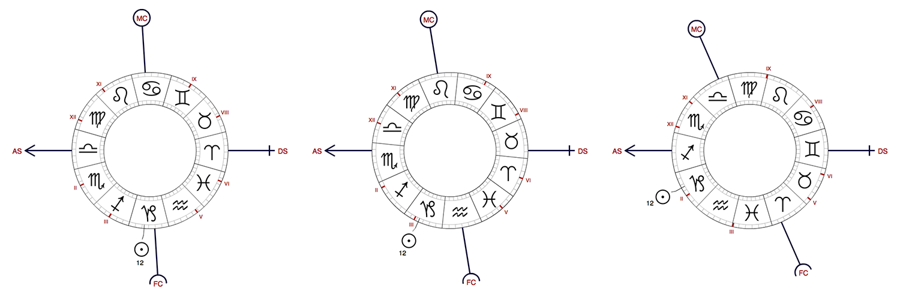
Comment to the figures above:
10) The Sun in Capricorn continues its course below the horizon. It is in House III, near the lower meridian or Bottom-of-the-Sky ; the Rising Sign (left) is Libra. Of an individual born at this hour, we will say that he is Capricorn Ascendant Libra.
11) The Sun in Capricorn begins its ascent towards the horizon. It is in House III; the Rising Sign (on the left) is Scorpio. Of an individual born at this hour, we will say that he is Capricorn Ascendant Scorpio.
12) The Sun in Capricorn approaches the horizon. It is in House I, close to its rise; the Rising Sign (left) is Sagittarius. Of an individual born at this hour, we will say that he is Capricorn Ascendant Sagittarius.
The inclination of the ecliptic plane with respect to the horizontal plane varies according to the terrestrial latitudes and the hours of the day. The figure below illustrates the movement phenomenon of “spin” of the ecliptic for a North latitude of 45° 11′ and an East longitude of 5° 42′, in 24 h and starting from the Ascendant at 0° Aries. Indeed, the local sphere being… local, the movements of the planets on the ecliptic and their height relative to the horizon vary according to the terrestrial latitudes.
We can thus see that, depending on the hours of the same day, the height of the Sign which culminates at the MC, the inclination of the ecliptic on the horizon and the azimuth (angle, in the horizontal plane, between the direction of an object and the direction of South — see the figure below) of the Ascendant Zodiac Sign.
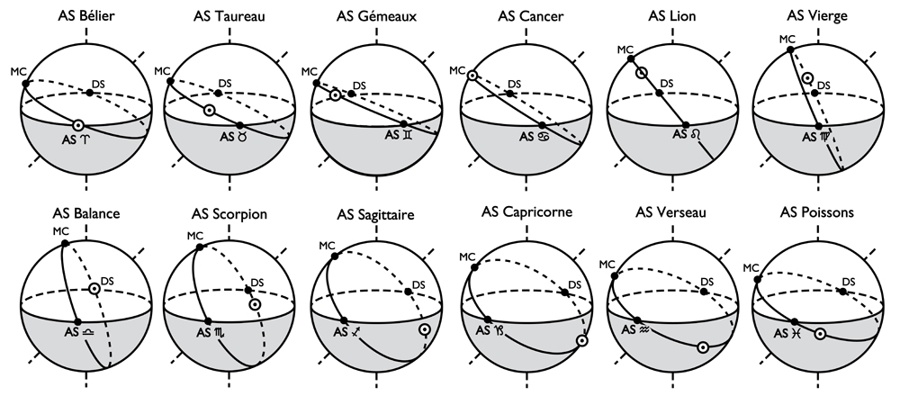
Astrologically, the Ascendant point corresponds to the beginning of House I, which extends over 30° (in Placidus domification) just below the eastern horizon. You will find here an account of the meanings that are attributed, rightly or wrongly, to this sector of the local sphere.
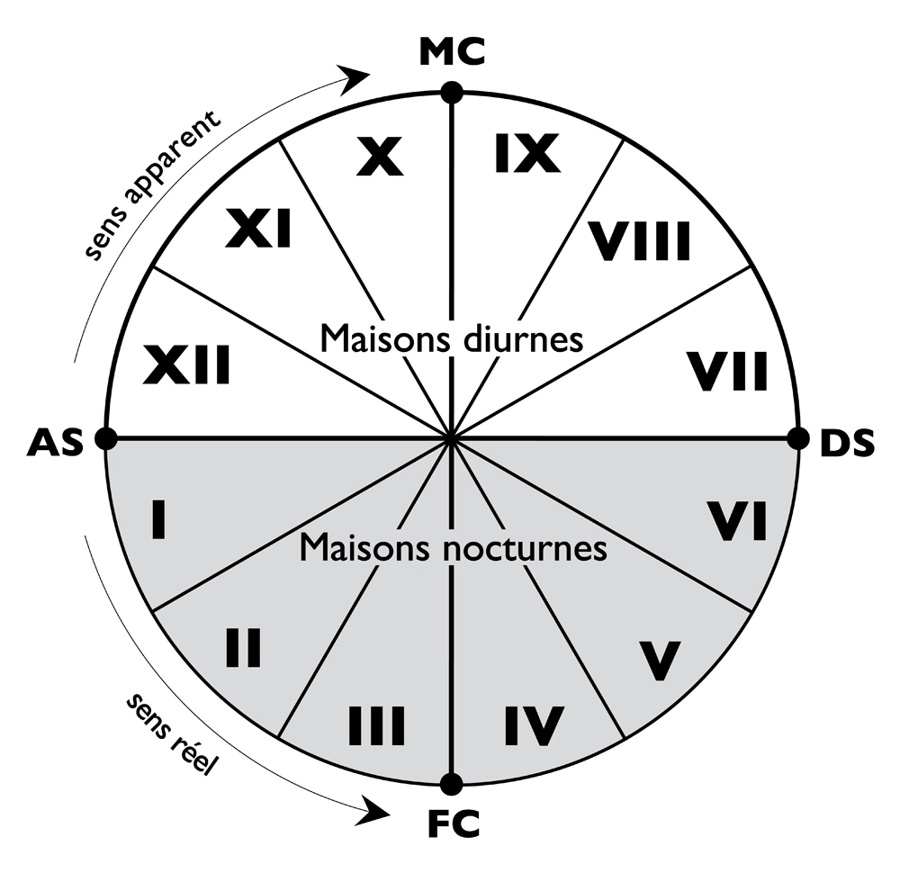 The Sun Sign/Rising Sign combination produces 144 (12 × 12) zodiac duos that can result in as many “astro-psychological profiles”. All kinds of rumors circulate about the Ascendant. According to some astrologers, one would be more like one’s Sun Sign during the first part of one’s life, and one’s Rising Sign during the second; it would confer on the individual his temperament, his dispositions, his appearance, his morphology, his awareness of himself, and would condition the most important characteristics of his external behavior and the way he is perceived by others; it would be essential to know which Aspects form and in which Sign and which House is the “Ascendant Ruler Planet” to judge the character and destiny of an individual.
The Sun Sign/Rising Sign combination produces 144 (12 × 12) zodiac duos that can result in as many “astro-psychological profiles”. All kinds of rumors circulate about the Ascendant. According to some astrologers, one would be more like one’s Sun Sign during the first part of one’s life, and one’s Rising Sign during the second; it would confer on the individual his temperament, his dispositions, his appearance, his morphology, his awareness of himself, and would condition the most important characteristics of his external behavior and the way he is perceived by others; it would be essential to know which Aspects form and in which Sign and which House is the “Ascendant Ruler Planet” to judge the character and destiny of an individual.
All this is false, archi-false. The temperament of an individual depends, from an astrological point of view, on all the zodiaco-planetary configurations at the time of his birth, and not on his Rising Sign alone; he takes his appearance and morphology from his genetic heritage, his eating habits, the care he takes of his own body, etc., and not from his natal horoscope. There “lord planet of the Ascendant” exists only in the imagination of backward-looking astrologers; and in fact, statistical studies show that the Ascendant point is as important as the Midheaven point. In other words, your Rising Sign is also “powerful” than the Sign that is at the MC, so much so that one could as well say: “I am Leo Midheaven Pisces” that: “I am Leo Ascendant Cancer.”
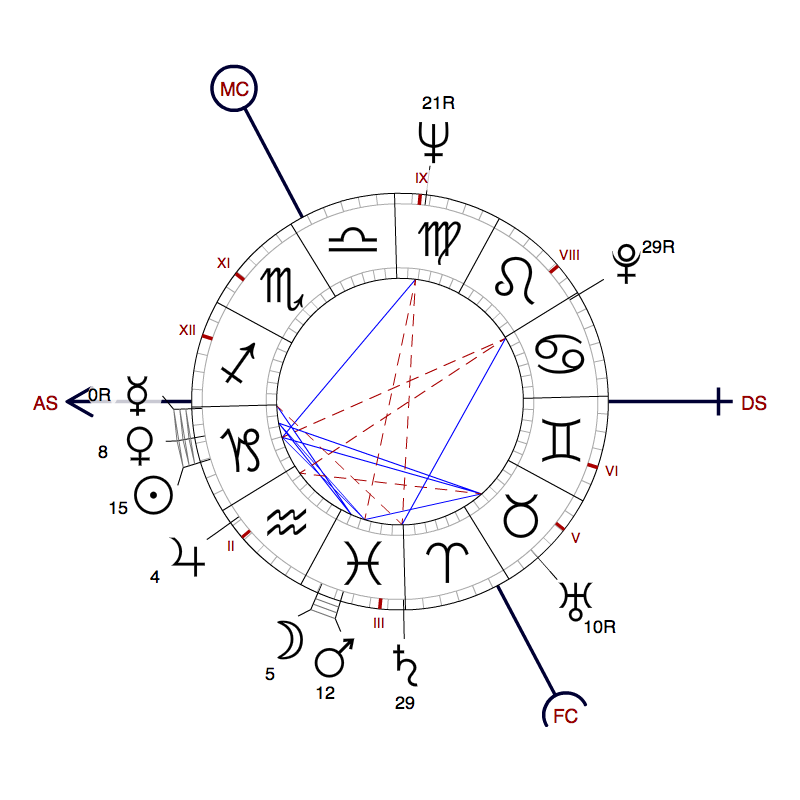 Also know that if no Planet occupies the Rising Sign, it is of negligible importance, given that a Sign exists only through the Planet which occupies it and of which it is only a rhythm. Any other Sign occupied by several Planets, especially if they are dominant, is then more important than the Rising Sign.
Also know that if no Planet occupies the Rising Sign, it is of negligible importance, given that a Sign exists only through the Planet which occupies it and of which it is only a rhythm. Any other Sign occupied by several Planets, especially if they are dominant, is then more important than the Rising Sign.
If the Ascendant is in the very first or very last degrees of a Sign and a Planet rises in the Sign preceding or succeeding the Ascendant Sign, it is this Sign which is valued, and not the Ascendant Sign.
This is for example the case in the Chart opposite (which is that of the Italian singer Adriano Celentano): the AS is at 28° 21′ from Sagittarius a Mercury-Venus-Sun conjunction rises in Capricorn just in- below the horizon: it is the sign of Capricorn that is important and dominant, and not Sagittarius, which is otherwise devoid of planets. In this same Chart, the Sign of Pisces, occupied by a conjunction Moon-Mars and Saturn is clearly more important than the Sagittarius Ascendant.
If it is true that in France the press horoscope dates back to 1934, the zodiac sign determined solely by the month of birth will have reigned unrivaled over popular astrology for almost 40 years. In recent years, popular works have drawn the attention of the general public to the existence of a Sign “mysteriously” related to birth time and more important than any other: the Ascendant.
This denomination does not concern any family heredity, any celestial ancestor. Ascendant derives from ancestry, Latin ascendere meaning to ascend, to rise. The Rising Sign is, precisely, the one that rises on the eastern horizon, at the precise moment of birth. It also seems more correct to speak of the degree or point of the ecliptic than of the Sign, but usage has consecrated the extension of meaning.
The ecliptic point at 180° from the Ascendant point is naturally called Descendant. It sets, it descends to the western horizon of the place of birth. Both terms apply to planets as well as stars. If Jupiter rises, it is said to be ascending, and if it is setting, it is said to be descending.
Our language has borrowed many things from astrology. “To have ascendancy”, “to be of a happy ascendant”, relate to the quality of the rising star or sign. These flattering expressions perhaps explain the value we place on knowing our Ascendant well. Outside of skeptics who do not believe in the year, the month or the hour, there are those who feel confusedly inferior by their ignorance of this capital Sign! Not knowing your Ascendant is too reminiscent of abandoned childhood. If you cannot know your time of birth, console yourself by thinking that in our geographical latitudes you are at least guaranteed to have, in any case, a rising sign. The inhabitants of extreme latitudes do not even have that…
His Sun Sign, everyone, in general, knows him. It suffices to open a journal with its astral rubric. His Sign is found there with the corresponding dates. Finally, one could believe that the months of the year being Signs, it is impossible to come under another Sign without leaving time and the calendar. If you think that to be Cancer you must absolutely be born between 21st–22nd June and 23rd–24th July, you will be frightened to learn, for example, that your Ascendant is Pisces, a sign that the same astrological page of your journal falls between 19th–20th February and 21st–22nd March. You will undoubtedly have the feeling that you are being taken on a boat trip in a fourth dimension for tourists-gogo.
Don’t confuse the signs of the zodiac with the seasons
These discomforts and confusions come from the lazy analogies established between the signs and seasons. It goes without saying that being born in summer, you cannot understand the intrusion of a Sign of Winter in your birth. One must have assimilated a massive dose of fantastic analogy to admit the March frosts during the heat wave.
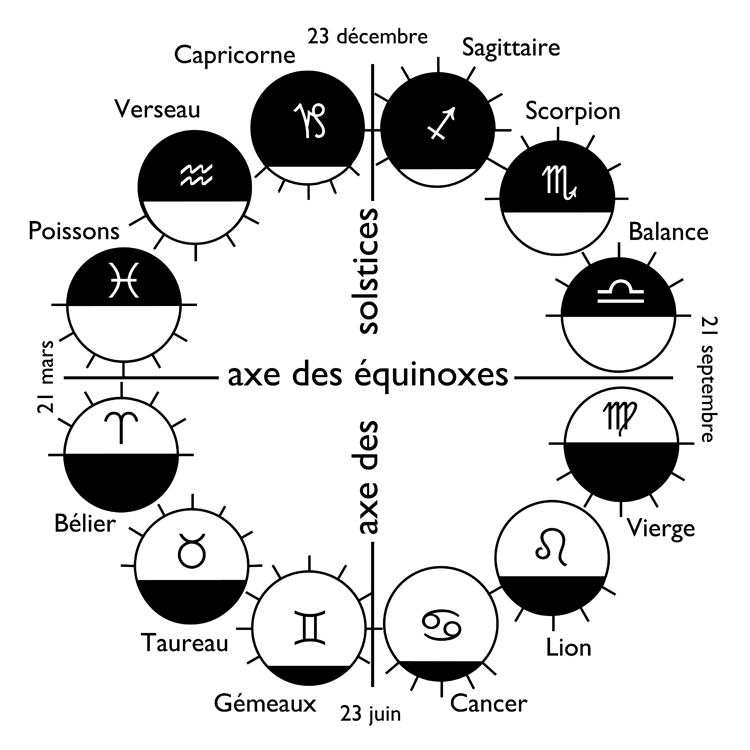 In truth, a Sign is not a degree of temperature, humidity or dryness. It is not climatic. He is a rhythm of light. Whether the day at the beginning of spring is dry or rainy, the vegetation late or early, we have, this day-night, a rhythm of 12 hours of day and 12 hours of night. Astronomically speaking, the Sun will be present for 12 hours above the plane of the horizon. He will be absent for the other 12 hours. Whether the day at the beginning of summer (22nd–23rd June) is cold, warm, blue or cloudy, will not change the fact that on this day-night, at the latitude of Paris, the Sun will remain about 16 hours above of the plane of the astronomical horizon and 8 hours below this plane. To fix ideas, we call presence frequency the ratio formed by 16 hours over 24 hours, full day length in mean solar time.
In truth, a Sign is not a degree of temperature, humidity or dryness. It is not climatic. He is a rhythm of light. Whether the day at the beginning of spring is dry or rainy, the vegetation late or early, we have, this day-night, a rhythm of 12 hours of day and 12 hours of night. Astronomically speaking, the Sun will be present for 12 hours above the plane of the horizon. He will be absent for the other 12 hours. Whether the day at the beginning of summer (22nd–23rd June) is cold, warm, blue or cloudy, will not change the fact that on this day-night, at the latitude of Paris, the Sun will remain about 16 hours above of the plane of the astronomical horizon and 8 hours below this plane. To fix ideas, we call presence frequency the ratio formed by 16 hours over 24 hours, full day length in mean solar time.
From 20th March 1976 (entry of the Sun in Aries) to 21st June 1976 (entry of the Sun in Cancer), the frequency of presence of the Sun, still for the latitude of Paris, goes from 12 h/24 h to 16 h/24 h, i.e. from 1/2 to 2/3. It is the variation of the frequencies of presence that truly and naturally characterizes the zodiac. Thus, we conceive that each degree of the zodiac, for a given geographical latitude outside the extremes, has its characteristic frequency. An analogist would say that it defines the character by a proportion of shadow and light, by a relief specific to each day that God makes.
The stars of the solar system, as well as the Moon, do not escape these definitions of the Signs. They too produce frequencies varying according to their celestial position (declination) and according to the geographical latitude of the observer. Therefore, a Moon in Aquarius – Sign in the heart of winter according to the analogy – will not need to create cold and icy conditions in summer to belong to this Sign. Her frequency of presence will be enough to define her as being in Aquarius.
Note that, from all traditions, a planet above the horizon plane is considered relatively more influential than a planet below this plane. The presence frequency can therefore be transformed into a relative power coefficient. This is the whole basis of an objective zodiac, rebellious to delirious inventions, kind 13th Sign, which is only a constellation, and to the villainous lies of anti-astrologism.
The Ascendant helps to differentiate the rhythm given by the day of birth. There is a phase of this rhythm
Since each degree of the ecliptic gives a rhythm, we can understand the zodiac sign as a grouping of neighboring rhythms. In truth, each day and each instant of this day, within a margin of 5 to 10 minutes, has its characteristic. The groupings in Signs of 30° come above all from the difficulty of the mind to enter into too great subtleties. The Ascendant, however, helps to differentiate the rhythm given by the day of birth. There is a phase of this rhythm.
In this integration of the Ascendant at a slower pace, there is no mixing of seasons. One can introduce modulation into a diurnal rhythm and be born Pisces by the hour, as a variation of Cancer by the Sun.
We know that the Earth revolves around the Sun in one year (365.2564 days in average time) and around itself in 24 hours. From the angle of the apparent movements the Sun progresses on average by 1° on the ecliptic, while, during this advance, the 360° of the zodiac pass on the horizon (without being materially visible, except at the planetarium of the Palais de la Discovery). The image of a circular treadmill completing a full turn while a moving body it carries moves discreetly in the other direction is very crude, but it suffices for our purpose to schematize the relationship between the two movements. Lovers of more rigorous definitions will refer to our article on the cosmography.
From the above, it appears that the combinations Sign of the month (Sun) — Sign of the hour (Ascendant), cannot be done anyhow. That’s not a 12 card deck from which two are drawn at random. The combinations have a chronology, an order of succession.
Ultimately, being born under this or that Ascendant means nothing in itself
Starting, for example, from Sun Aries-Aries Rising (sunrise on a spring day), the sequence, taking into account only the Signs and not the degrees, will necessarily be: Aries-Taurus, Aries-Gemini, Aries-Cancer, Aries-Leo… so far exhaustion of the twelve Signs. Continuing in this way for each day, we will reach the entry of the Sun in Taurus which will give another series of combinations, as well as the passage of the Sun in Gemini, then in Cancer, and following until back to Aries.
Ultimately, being born under this or that Ascendant means nothing in itself. It is born at a precise moment of a large clock cycle with at least two hands. The small one for the Sun Sign (the month), the large one for the Ascendant Sign (hour). The natal chart is only a summary representation of a mega-clock made up of several hands whose movements, complex for the terrestrial observer, are considerably simplified when they are designed with the Sun as their center.
Do not think that this horological vision is unimportant for astrology. It firmly links it to the reality of the world and to all research on time, duration, cycles and rhythms. In the spatial view of astrology, the most widespread, the hands of the clock are not understood as a time which has meaning only in relation to the program of a whole day. No, the planets are pawns, or large pieces occupying more or less successfully the compartments formed by the Signs and the “Houses”. It is not a clock but a chessboard.
And this explains the interpretations where the Sun Sign and the Ascendant symbolize two distinct aspects of the personality artificially split into “me social” (Sun sign) and “private me” (rising sign). We imagine Landru, Sun-Aries and Ascendant Taurus, cajoling and a fine cook in private for the ladies he would have loved so much. It is true, we will be told, that Landru was born at the sunrise of a reputedly detestable planet (Pluto). But Heydrich (head of the Gestapo, died in Prague on 4th June 1942), with his Sun-Pisces and his Ascendant Leo, does not seem to have limited the taste for parade and power to the private sector.
Faced with these breaches of the rule, abandoning all theory, some practitioners prefer to minimize the Zodiacal Signs and consider the combinations of two or three Signs as a backdrop, a general hue quickly eclipsed if the sky otherwise shows powerful planetary configurations. This rule still suffers from an exception when the native sky contains a strongly occupied Sign.
In a rare stretch of logical synthesis, Robert Dax, author of Zodiacal Psychology, treated the 12 Signs and their combinations in pairs, assigning the “temperament” to the rising sign and the “character” to the Sun Sign. These terms restore between the two Signs the links broken by the distinction between “me social” and “private me”. Jean Carteret sees in a Sign “the tool” of the other. Which is also a non-separatist position.
The astronomical phenomenon, as we have seen, indicates a modulation of the Sun sign by that of the hour, which is still only an approach. A transposition of this phenomenon consists in considering one as a variation of the other. In ordinary language, if you are Aries-Taurus one could say that you must live the most taurian aspect possible of Aries, or, another formula, “live Aries in Taurus”.
The stated relationship invites to know perfectly the characteristics of each Sign, so as to grasp in what and how they can, not coexist and overlap, but encourage the personality to coordinate its contradictions and, if possible, draw a dynamic from it. This way of seeing refers to the dominant planets at birth as indicators of ease or difficulty in the search for synthesis and unity.
There is no isolated element in a horoscope. Even when combining two Signs, the interpreter must take into account the dominant planetary factors, non-horoscopic assets and handicaps.
To consider the relationship between Signs in the proposed spirit, it is necessary to get out of the definitions by stereotyped character traits. If you think the Libra is charm, seduction, sweetness, and the Aries arrogance, outburst, warrior mood, it will be impossible for you to imagine the most combative aspect of Libra. But, if you know that Libra has the adaptive function of specifying its choices by linking them to a context, while Aries applies to live them intensely, far from being incompatible, the two functions will adjust in an axis of strength which does not appear with the couple tenderness-roughness, gentleness-aggressiveness.
As François Mitterrand, Charles de Gaulle was Sun-Scorpio Ascendant-Libra. At the level of such personalities, the Libra aspect of Scorpio can be in the refinement, the polishing of causticity, and, above all, in the art of serving firm and subterranean purposes by using the opportunities of the political context. Richard Nixon, Sun-Capricorn Rising-Virgo, returned to the pinnacle of power, lost it in the needy sidelines of struggles for self-preservation (Virgo). Michel Jobert, with an inverse formula, Sun-Virgo Ascendant-Capricorn, seems to want to elevate the pragmatisms of democracy into a pyramid…
So don’t focus on your Sun sign, add the Ascendant to it, and to understand both, the easiest way is to learn astrology as a school of realism, psychology and logic.
▶ Your zodiac Sign
▶ Signs and seasons
▶ Planetary trios in Signs
▶ The zodiac and the precession of the equinoxes
▶ The astronomical reality of the zodiac
▶ The human reflexology zodiac
▶ Autour du zodiaque : de l’eau dans un Signe de Feu ?
▶ Zodiaque et sphère locale
▶ Mythologie du zodiaque
▶ Zodiaque et formes de l’inhibition
▶ Do we change character by changing Sun sign?
▶ Énergie-Espace-Temps-Structure et zodiaque
▶ Genèse du zodiaque conditionaliste
▶ L’horloge photopériodique du genou
▶ Sun Sign and Rising Sign
▶ Astrologie, adaptation & inadaptation
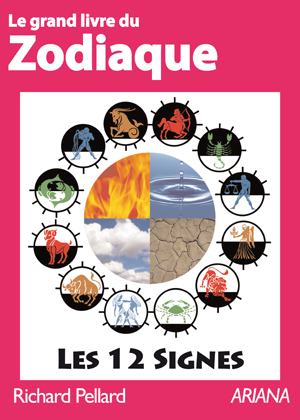
Le grand livre du zodiaque
par
180 pages. Illustrations en couleur.
Ce livre présente et explique les trois zodiaques : celui du décor des constellations, celui de l’astrologie traditionnelle basé sur les Quatre Éléments symboliques (Feu, Terre, Air & Eau) et celui de l’astrologie naturelle basé sur les phénomènes astronomiques objectifs.
Téléchargez-le dès maintenant dans notre boutique